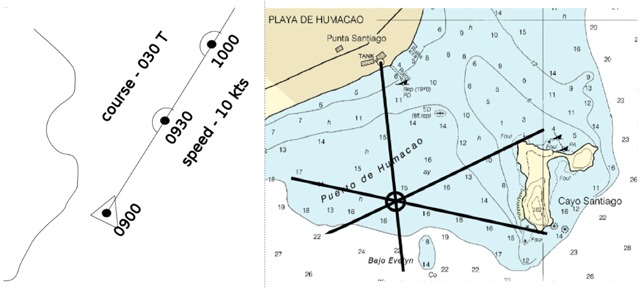June 27, 2011
Dead Reckoning

Out of high school, I joined the Navy. The most interesting job from my point of view was that of the Operations Specialist, the dark room behind the bridge full of radars, computers, radios and many other wondrous things all bejeweled with lights. Dead reckoning was one of the first things that we had learned in order to join that special fraternity of sailors, characters all, faces as they were lit by the glowing jewels. The ship at sea was like an individual scanning, straining for information; much like it is when you get up from bed at night, straining to see the hands of the clock, making your way down the hallway...
Marine navigationIn marine navigation a "dead" reckoning plot generally does not take into account the effect of currents or wind. Aboard ship a dead reckoning plot is considered important in evaluating position information and planning the movement of the vessel.
Dead reckoning begins with a known position, or fix, which is then advanced, mathematically or directly on the chart, by means of recorded heading, speed, and time. Speed can be determined by many methods. Before modern instrumentation, it was determined aboard ship using a chip log. More modern methods include pit log referencing engine speed (e.g. in rpm) against a table of total displacement (for ships) or referencing one's indicated airspeed fed by the pressure from a Pitot tube. This measurement is converted to an equivalent airspeed based upon known atmospheric conditions and measured errors in the indicated airspeed system. A naval vessel uses a device called a pit sword (rodmeter), which uses two sensors on a metal rod to measure the electromagnetic variance caused by the ship moving through water. This change is then converted to ship's speed. Distance is determined by multiplying the speed and the time. This initial position can then be adjusted resulting in an estimated position by taking into account the current (known as set and drift in marine navigation). If there is no positional information available, a new dead reckoning plot may start from an estimated position. In this case subsequent dead reckoning positions will have taken into account estimated set and drift.
Dead reckoning positions are calculated at predetermined intervals, and are maintained between fixes. The duration of the interval varies. Factors including one's speed made good and the nature of heading and other course changes, and the navigator's judgment determine when dead reckoning positions are calculated.
Source: Wikipedia.
Posted by Dennis at June 27, 2011 5:09 AM
Leave a comment